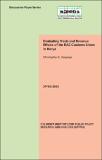Discussion Paper No. 131 of 2012 on Evaluating Trade and Revenue Effects of the EAC Customs Union in Kenya
View/
Publication Date
2012Author
Type
KIPPRA Publicationsviews
downloads
Metadata
Show full item recordBy
Onyango, Christopher H.
Abstract/
This study examines the impact of the EAC customs union on trade, revenue and welfare on the Kenyan economy over the 5-year transitional period. Using a simple partial equilibrium method to measure static effects, the analysis suggests net benefits in trade creation, revenue generation and welfare gains for Kenya from the EAC trade regime. The simulation results also indicate that there have been net positive trade effects in Kenya under the EAC customs union regime. The largest trade impact occurred in the products designated under the EAC list of sensitive products. These include prepared foodstuffs (24.9% of total trade), textile and textile products (22.8%), paper products (20.3% of total trade) and vegetable products (17.2%). In addition, net welfare effects were positive, implying that producers and consumers in Kenya are better off under the customs union regime. The welfare gains can be attributed to realignment of prices and the reduction of domestic prices induced by Kenya’s tariff reforms, which create opportunities for investments, reallocation of resources and efficiency gains. Besides, there are regional efforts towards trade facilitation and addressing non-tariff barriers, including improvement in customs administration, reduced police check-points, and improved clearances at the Port of Mombasa. Finally, fiscal disruptions have been minimal, largely attributed to improved trade and economic performance coupled with better customs administration. The study recommends the need for Kenya to expand its production and export base in order to take full advantage of the expanded regional market and to sustain fiscal reforms with a view to minimizing the impact of tariff revenue losses, among others.
Subject/
Trade and Industry; Revenue Generation; Investment Flows; Regional Integration; East African Community
Publisher
The Kenya Institute for Public Policy Research and Analysis (KIPPRA)Series
DP/131/2012;Collections
- Discussion Papers [342]

